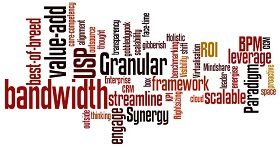 Is your company, product or service innovative, cutting-edge or disruptive? If so, you probably don’t need to use those words.
Is your company, product or service innovative, cutting-edge or disruptive? If so, you probably don’t need to use those words.
Call them what you will—buzzwords, colloquialisms, industry terminology, professional slang—unless you’re a professional beat boxer creating a viral video about jargon, they have no place in your vocabulary, written or otherwise.
The secondary definition of jargon is “the technical terminology or characteristic idiom of a special activity or group.” The primary definition, however, is probably more accurate: “confused unintelligible language.”
Writers turn to jargon when they know very little about the content and feel they need to use “big words” to fill space or attempt to hide their inadequate grasp of the material. Sometimes the marketing department can be overruled by an over-cautious legal team that defaults to jargon rather than describe a product’s actual benefits—which could presumably result in litigation if the product or service fails to deliver.
An intelligent reader, however—especially a reporter or investor who reads these every day—will see through the veil and either stop reading or stop believing the message.
There is always a way to say something better. For example, if your product or technology platform can easily accommodate new elements or grow beyond its current functionality or geography, then don’t just say its “scalable,” make its benefits clear. If your company is award-winning, then describe the awards you’ve won and why, or provide a link your company’s awards page.
If your product or service is truly bleeding edge, paradigm-shifting or robust, your messaging should clearly reflect these qualities in the description of what you do or how your product solves a problem.
When writing marketing copy, whether for a website, brochure, newsletter or press release, the primary goal is to keep the audience engaged while clearly describing the benefits of a product or service. Nothing disengages a reader more quickly than does the use of tired, staid language that simply doesn’t say anything.
The next time senior management asks you to include value-added language like core competencies, best practices or optimized solutions in your writing, ask them what they really want to say. Then, put on your thinking cap, reach out and get buy-in from your tiger team to leverage your company’s message and take your content to the next level. But please, in the name of Chaucer, do not use ANY of those terms.
-Brian Hyland
Photo via Flickr account Gavin Llewellyn
